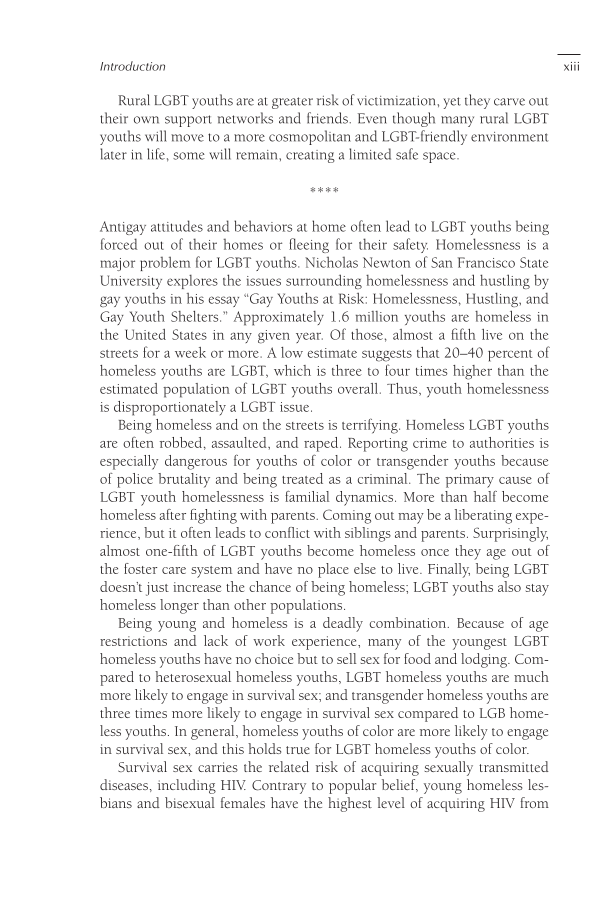Introduction xiii Rural LGBT youths are at greater risk of victimization, yet they carve out their own support networks and friends. Even though many rural LGBT youths will move to a more cosmopolitan and LGBT-friendly environment later in life, some will remain, creating a limited safe space. **** Antigay attitudes and behaviors at home often lead to LGBT youths being forced out of their homes or fleeing for their safety. Homelessness is a major problem for LGBT youths. Nicholas Newton of San Francisco State University explores the issues surrounding homelessness and hustling by gay youths in his essay “Gay Youths at Risk: Homelessness, Hustling, and Gay Youth Shelters.” Approximately 1.6 million youths are homeless in the United States in any given year. Of those, almost a fifth live on the streets for a week or more. A low estimate suggests that 20–40 percent of homeless youths are LGBT, which is three to four times higher than the estimated population of LGBT youths overall. Thus, youth homelessness is disproportionately a LGBT issue. Being homeless and on the streets is terrifying. Homeless LGBT youths are often robbed, assaulted, and raped. Reporting crime to authorities is especially dangerous for youths of color or transgender youths because of police brutality and being treated as a criminal. The primary cause of LGBT youth homelessness is familial dynamics. More than half become homeless after fighting with parents. Coming out may be a liberating expe- rience, but it often leads to conflict with siblings and parents. Surprisingly, almost one-fifth of LGBT youths become homeless once they age out of the foster care system and have no place else to live. Finally, being LGBT doesn’t just increase the chance of being homeless LGBT youths also stay homeless longer than other populations. Being young and homeless is a deadly combination. Because of age restrictions and lack of work experience, many of the youngest LGBT homeless youths have no choice but to sell sex for food and lodging. Com- pared to heterosexual homeless youths, LGBT homeless youths are much more likely to engage in survival sex and transgender homeless youths are three times more likely to engage in survival sex compared to LGB home- less youths. In general, homeless youths of color are more likely to engage in survival sex, and this holds true for LGBT homeless youths of color. Survival sex carries the related risk of acquiring sexually transmitted diseases, including HIV. Contrary to popular belief, young homeless les- bians and bisexual females have the highest level of acquiring HIV from
Document Details My Account Print multiple pages
Print
You have printed 0 times in the last 24 hours.
Your print count will reset on at .
You may print 0 more time(s) before then.
You may print a maximum of 0 pages at a time.




































































































































































































































































































































































































































































































































































































































































































































































































































































































































































